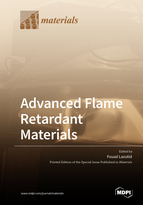Advanced Flame Retardant Materials
A special issue of Materials (ISSN 1996-1944).
Deadline for manuscript submissions: closed (31 October 2019) | Viewed by 40344
Special Issue Editor
Interests: (bio)polymers; flame retardancy; polymer recycling; (nano)composites; reactive extrusion
Special Issues, Collections and Topics in MDPI journals
Special Issue Information
Dear Colleagues,
Recent disasters caused by the spread of fire in buildings and in transportations remind us of the importance of fire protection. Using flame-retardant materials presents one important element of the firefighting strategy, which aims at preventing fire development and propagation. These materials are used in different applications, such as in textiles, coatings, foams, furniture, and cables.
The development of more efficient and environmentally friendly flame-retardant additives is an active multidisciplinary approach that has attracted a great deal of interest. Works aims at the development of new, sustainable, flame-retardant additives/materials, providing high performances and low toxicity. These also concern studying their properties during ageing and recycling, as well as modeling physical and chemical processes taking place before ignition and during their combustion.
The development of sustainable flame retardants, as well as an understanding of their modes of action, presents a strong link between all these topics and covers a large spectrum, from organic chemistry, materials engineering, and toxicology to physics and mathematics.
This Special Issue aims to provide an excellent opportunity for publishing your latest advances in these research fields. Full papers, review articles and communications are all welcome.
Dr. Fouad Laoutid
Guest Editor
Manuscript Submission Information
Manuscripts should be submitted online at www.mdpi.com by registering and logging in to this website. Once you are registered, click here to go to the submission form. Manuscripts can be submitted until the deadline. All submissions that pass pre-check are peer-reviewed. Accepted papers will be published continuously in the journal (as soon as accepted) and will be listed together on the special issue website. Research articles, review articles as well as short communications are invited. For planned papers, a title and short abstract (about 100 words) can be sent to the Editorial Office for announcement on this website.
Submitted manuscripts should not have been published previously, nor be under consideration for publication elsewhere (except conference proceedings papers). All manuscripts are thoroughly refereed through a single-blind peer-review process. A guide for authors and other relevant information for submission of manuscripts is available on the Instructions for Authors page. Materials is an international peer-reviewed open access semimonthly journal published by MDPI.
Please visit the Instructions for Authors page before submitting a manuscript. The Article Processing Charge (APC) for publication in this open access journal is 2600 CHF (Swiss Francs). Submitted papers should be well formatted and use good English. Authors may use MDPI's English editing service prior to publication or during author revisions.
Keywords
- Polymers
- Composites
- Sustainability
- Bio-based flame retardants
- Combustion
- Smoke toxicity
- Fire testing
- Ageing and recycling







